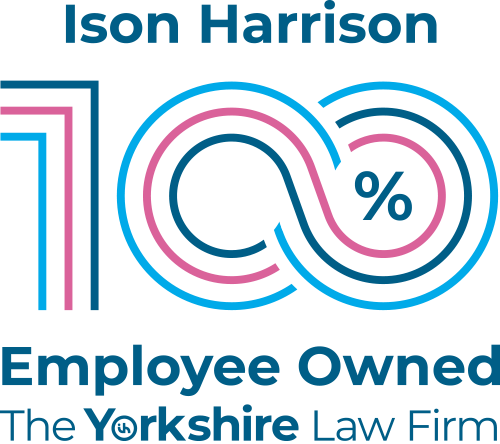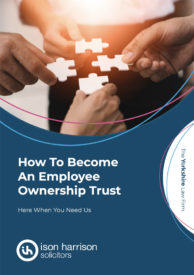Introduction
An Employee Ownership Trust (‘EOT’) offers an innovative and tax efficient mechanism by which a business owner can wholly or partially exit a business whilst allowing the employees a stake in the business from which they will benefit.
There are many benefits to becoming an EOT but there are also plenty of matters to consider. Increasingly however this structure is being engaged by some of the most successful businesses in the UK. Some of the well-known businesses who are employee owned include John Lewis, Richer Sounds, Aardman Animations (the team behind Wallace & Gromit) and, of course, Ison Harrison Solicitors.
The purpose of this guide is to explain some of the benefits and considerations for anyone considering becoming an EOT.

Ison Harrison Solicitors became an employee-owned business in early 2022.
What Is an Employee Ownership Trust?
In 2012, the Government commissioned a review (called the Nuttall Review) looking into the benefits of Employee-Owned businesses. The review recommended that the government incentivise business owners to make the transition to Employee-Ownership by granting business owners looking to exit a business (‘Sellers’) tax benefits in the form of relief against Capital Gains Tax to encourage Sellers to sell their businesses to employees.
Under The Finance Act 2014, the government put in place legislation to provide for tax efficient disposals of controlling interests in businesses by Sellers to their employees, subject to meeting certain criteria.
In essence an Employee Ownership Trust (‘EOT’) is a trust set up as a vehicle to acquire the Seller’s shares in a business for the benefit of all employees.
The Seller sells their shares to the EOT whereby the EOT, via a new limited company, will own some or all of the shares in the business (‘the Company’). The EOT is managed by a board of trustees who will make decisions for the benefit of the employees.
The Company will still be managed by a board of directors who may or may not also be trustees. The purpose of the board of directors is to manage the Company profitably for the ultimate benefit of the EOT. This will include, for example, the board of directors making decisions about the available profits in the business to distribute to the EOT. The EOT will then distribute the profits to the employees in accordance with the scheme rules and subject to some statutory restrictions.
Ultimately, an EOT offers an alternative route for a Seller to exit the Company rather than, perhaps, a trade sale to a competitor or conventional management buy out.
What Are the Benefits to a Seller?
EOT’s have become increasingly popular in recent years for many reasons. One of the main reason for their popularity is that under Sections 236H-236U Taxation of Chargeable Gains Act 1992, a Seller can sell their shares in the Company to an EOT and not have to pay any Capital Gains Tax.
This is subject to certain conditions, for instance the Seller must sell a controlling interest. This can however result in a significant tax saving particularly given the reduction in the lifetime allowance for CGT.
Another benefit for a Seller however is that whilst they may stay on for a period of time after a sale, there is a greater degree of control over the transition than perhaps a Seller would have with a trade sale where a new management team potentially would come in and disrupt the existing business.
A Seller may also be able to maintain an element of control and influence over a business during any earn out period for the sale. This can offer comfort to a Seller.
Many Sellers also appreciate the opportunity to give back to their employees and many businesses notice a significant improvement in trading performance after conversion to an EOT.
What Are the Benefits to the Employees?
For many the prospect of owning a business is not feasible for many reasons including their ability to raise finance.
An EOT allows all employees to indirectly ‘own’ the Company. Employees will have a greater degree of influence in how the Company is managed and operated.
Further, Employees will receive a share of the profits of the Company. Under current tax legislation, Employees can receive up to £3,600 per annum tax free via an Employee Ownership Trust. Any profit distribution above this threshold is taxable at income tax rates.
In our experience, employees in an EOT feel more invested in a Company and staff retention tends to improve.
Ordinarily an EOT will also set out an Employee Forum and will elect Employee Representatives. This benefits both the employees and the Company as it allows a more open dialogue between the management team and employees often resulting in greater collaboration and transmission of ideas.

Speak with an expert today!
For more information regarding Employee Owned Trusts and how Ison Harrison Solicitors can help, contact us today.
What is the Process to Becoming an EOT?
Becoming an EOT is not necessarily a quick process as there are several steps which have to be followed including seeking approval from HMRC.
The starting point is to seek advice from a Solicitor and an Accountant to ensure than an EOT is the right structure for you, your personal circumstances, your business and your longer term aspirations. There is a lot to consider and whilst an EOT is a fantastic structure for many, it is not necessarily the right structure for everyone.
Once you have decided to proceed with an EOT, it will be necessary to arrange for an independent valuation of the Company to be conducted. This will look at various matters including the profitability of the Company, the net assets in the Company and market conditions.
Whilst this process is being undertaken, thought should be given to a potential payment structure for any sale price. More often than not a Seller is paid over a period of time, potentially years, following the sale to an EOT but it may be possible for the business to finance some or all of the sale. It will also be necessary to consider the working capital requirements of the business and the cash to be retained for operating costs.
Consideration will also need to be given as to whom will become the management team or the board directors. It may be that there is an existing management team but consideration may need to be given as to whether there needs to be changes to the remuneration structure for the directors or whether a separate directors bonus pool needs to be created.
It will be necessary to consider who will be the trustees of the EOT. You would ordinarily have a least one employee trustee so consideration will need to be given as to who would be appropriate and at what point such a discussion should take place. It will be necessary to appoint an independent trustee unconnected to the business and this will need to be considered. Ison Harrison Solicitors can offer independent trustee services.
Once the valuation is received, it will be necessary to seek tax clearance from HMRC as HMRC will need to approve the structure to ensure that the Seller and the Employees receive the appropriate tax benefits.
Once HMRC tax approval has been received, it is time to start preparing the paperwork for the sale. This is not a straight process and ties in with the earlier decision making around the directors, the trustees and how a payment structure would work.
In our experience, early engagement with employees even before a sale is concluded is hugely beneficial. Ultimately the EOT will be for their benefit and they will want a say in how this is to be structured. One of the considerations, for example, is how the profit share is to be distributed. There are strict rules as to how profits are distributed, for example will everyone receive the same distribution or will it be linked to something like an employee’s salary or length of service.
It will be necessary to set up a new trust company and create the trust through a trust deed. IT will be the trust company which will purchase the shares.
Once the HMRC tax clearance is obtained approving the sale price and the legal paperwork is completed, it is then possible for the transaction to ‘complete’. Completion will be the point at which legal title to the shares will transfer to the trust company.
After completion, there are a number of additional steps including filing paperwork with HMRC for stamp duty, updating Companies House and filing personal tax returns for which it is advised that you obtain professional advice from a Solicitor and Accountant.
How Does the Board of Directors Work?
The Board of Directors of the Company will be responsible for managing the Company. The Board of Directors will make the day to day decisions about the operations of the business including expenditure and the direction of the business.
It is possible for the Seller to remain on the Board of Directors after a sale, indeed it is advisable for the Seller to do so at least until the Seller has received all of the payments due under the sales contract. However as part of the rules around an EOT, the Seller has to relinquish full control of the Company and so a wider Board of Directors should be appointed if they do not already exist.
The Board of Directors operate the Company for the benefit of the employees and will make recommendations of the trust company around the amount which is available for distribution in the Company.
The Board of Directors have statutory responsibilities owed to the Company under the Companies Act 2006 and to the shareholders, ultimately being the EOT.
How Does the Board of Trustees Work?
The Board of Trustees will ordinarily consist of at least 3 trustees made up of one of the Sellers, an employee and an independent trustee.
There can be more trustees that this however in order for a Seller to demonstrate that they have relinquished control they need to have other trustees in place.
Trustees do not run the Company but the approve key decisions of the board, primarily in respect of the distributions to the employees.
How is the Seller Paid?
Ordinarily, the Seller is paid over a period of time out of the profits in the Company. There may be an amount paid on completion in respect of excess cash in the business.
In some situations it is possible and appropriate for the Company to take out finance to fund some or all of the purchase price. The exact structure will depend on the financial position of the business and the value of the deal.
In most situations a Seller will want to ensure that they have protection to ensure that they are paid. This may take the form of a debenture over the Company or a charge over the shares sold.
It would also be common for a Seller to be able to limit the extent to which the Company can incur significant financial expenditure or take out additional credit until the purchase price is paid.
The exact payment profile will need to be considered on a matter by matter basis.
Practical Considerations of becoming an EOT
As mentioned above, becoming an EOT is not a suitable structure for everyone.
An EOT may not be suitable for instance for a business that does not have, or can cannot create, a management team from the existing workforce. Equally an EOT may not be suitable in situations where the Sellers involvement in the business is integral to the operation of the business. More often than not even if a business is not suitable for an EOT initially, with strong professional support a business can be molded into structure and position suitable for such an exit.
In addition to the points already mentioned, there are wider considerations such as:
- Are you a business which is subject to rules from a particular regulator such as the SRA, CQC or similar? If so, there may be need to comply with the regulators requirements and seek approval of this structure;
- Who will be your management team and how will they react to this structure? Not everyone will necessarily be in favour of the structure particularly if, for example, they had envisaged a possible scenario whereby they acquired the business in a more conventional management buyout. Consideration may need to be given to whether an EOT should be set up alongside another form of share scheme, possibly growth shares, or whether a separate directors bonus pool needs to be created to reward directors for the performance of the business;
- How will you engage with staff? Staff engagement is crucial to making a success of a transition to an EOT but statistically many businesses notice a ‘bounce’ in turnover and profitability after becoming an EOT. Also consider whether being an EOT may be attractive for potential recruits.
- How will handover work in practice? As a business owner you will be used to dealing with the intricacies of the business with everything from HR issues to finances and customer relations. In all likelihood, a Seller will need to stay in the business for a period of time to ensure a safe hand over but you will also need to consider whether the incoming management team have the skills and knowledge to take over the Sellers role.
- What is the position with the external contracts? Some contracts require approval or notification of a change of control. This is the same with any sale but it may be necessary to explain the new structure to external parties in advance of completion. Thought will need to be given as to how to approach this.
- Who will be your independent trustee?
- How will the profit share work for employees? There are multiple options and you will need to find the right fit for your business.
As you can see there is a lot to consider and early advice is required.
Timeline of becoming an EOT
The timeline for becoming an EOT will depend on a wide series of circumstances. A straight forward matter might be completed in as little as 8-9 months whereas more complicated businesses could take 2-3 years.
Typically we would expect:
- Initial Consultation with Accountants and Solicitors – 2-4 months
- Independent Valuation – 2 months
- Application to HMRC and approval – 2- 3 months
- Consultation with Management team and discussion on the scheme, identifying trustees and employee engagement as appropriate – 2 – 4 months
- Preparation of legal paperwork and set up of the trust company – 2-3 months
How We Can Help
As a law firm which is 100% owned by our employees within an EOT, we are ideally placed to advise businesses on the process of becoming an EOT as we are able to advise on both the legal process and the practical issues.
Our Director and Head of Corporate and Commercial was directly involved in Ison Harrison becoming an EOT.
The advice we can offer includes:
- Assisting owners assessing whether an EOT is suitable for them;
- Preparing the legal documents and managing the process of becoming an EOT;
- Advising incoming management teams or the trust as the ‘buyer’ to negotiate the structure of the deal and payment of the consideration;
- Advising on financing the sale and introducing appropriate commercial finance brokers to fully or partially fund the transaction.
- Acting as an independent trustee;

Speak with an expert today!
For more information regarding Employee Owned Trusts and how Ison Harrison Solicitors can help, contact us today.




